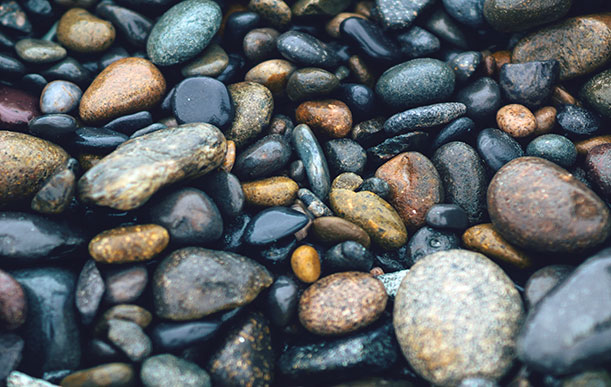BOOMbox at Home: Activities with Rocks
October 21, 2020

All about Rocks
We are surrounded by lots of different kinds of rocks. In fact, the entire outer layer of planet Earth, the crust, is made of rocks. But what exactly are rocks?
Rocks are made of lots of minerals stuck together. A mineral is something that is inorganic, naturally occurring, and solid. This means that:
- A tree is not a mineral. It is a living thing, which means that it is organic, not inorganic.
- Plastic is not a mineral because it was made by human hands. It is not naturally occurring.
- Water is not a mineral because it is liquid, not solid.
On the other hand, a quartz crystal is a mineral because it is inorganic (it’s not a living thing), it’s naturally occurring (it was made by nature), and it’s solid.
What are some other minerals you can think of? Are diamonds minerals? Is steel a mineral? What about ice? If you are stuck, you can watch this brief introduction to minerals video.
We can get a better understanding of how minerals are created by making our own rock candy to enjoy at home. Learn how to make rock candy. As you participate in this activity, think about these questions: Is rock candy really a rock? And why are crystals different shapes?
Are fossils rocks?
Fossils are remains of really old plants and animals that have been preserved in minerals. They tell us a lot about what life was like millions of years ago, when humans didn’t exist yet and there were no history books to read. Fossilization is the reason why we can still visit Sue the T. rex at the Field Museum today.
There are many types of fossils. Some fossils are made when the hard parts of a plant or animal, like a skeleton, get buried in lots of sediment. Other types of fossils are made when a plant or animal leaves an imprint behind, like dinosaur footprints.
You can make your own fossils by pressing an item into a mold made with flour and used coffee grinds or salt dough. Get creative with what you choose to fossilize. Maybe you can make fossils with your hand print in them, or a sea shell. Your fossils might even be the subject of a scientific discovery millions of years in the future!
Based on what you’ve learned when making your own fossils, do you think fossils are rocks?
What do rocks look like in Illinois?
We are surrounded by lots of really cool rocks in Illinois. You can use the Illinois State Geological Survey’s Guide to Rocks and Minerals to learn more about the rocks you around you, or go rock hunting along the lakefront with the Field Museum’s Beachgoer’s Guide to Fossils and Rocks.
The geology of the land around us can tell us a lot about the past and present of Illinois. We know that millions of years ago, Skokie was at the bottom of a tropical sea because we have found fossils of sea creatures like the Tully Monster. In the last great ice age, tens of thousands of years ago, Skokie was covered by the Wisconsin Glacier, which dropped down the Big Rock at Morton Arboretum. As the Wisconsin Glacier moved away, it left behind a flat landscape that was covered with fertile topsoil. This meant that Illinois had lots of land that was suitable for farming.
The abundance of land suitable for farming led the Native American Mississippian people to build Cahokia, a major city in southwestern Illinois. It also meant settlers sought to force the people of the Council of Three Fires, the Ojibwe, Potawatomi, and Odawa as well as the Menominee, Miami, and Ho-Chunk nations out of their homelands through the Treaty of Chicago because they wanted to use the land for farming. Learn more about where the people who were forcibly removed are now living and thriving and how Chicago has the third largest urban Indian population in the United States. However, there are no federally recognized American Indian lands or tribes within Illinois.
Scavenger hunt competition
You don’t need to go to a rock quarry or a museum to find interesting rocks. In fact, you can find them inside your own home. Your toothpaste probably has fluoride in it to protect your teeth, and fluoride comes from fluorite, Illinois’s state mineral. Staff member Michelle found a hefty chunk of granite in her kitchen. It had been shaped into a mortar and pestle and could be used to crush spices into powder or make tasty guacamole. Find out other weird ways rocks have been used.
Have you found a cool rock or something awesome made out of rocks? We’d love to see your discovery, so send your photo to us by emailing boombox@skokielibrary.info and we will send you a digital sticker in return.
Scientist of the Week
Zelma Maine-Jackson is a geologist, which means that she studies rocks and the Earth. Some of her jobs have included searching for uranium in the Rocky Mountains and decontaminating groundwater to make sure the water that people use is clean and free of radioactivity. Maine-Jackson also speaks up for communities that have been damaged by nuclear waste.
Maine-Jackson is part of the Gullah-Geechee Nation and is a founding member of the National Association of Black Geoscientists. Her connection to science stemmed from her grandmother, who taught her how to use iron-rich red clay to help women who were iron deficient. She loves geoscience because it’s like reading a book.
“I’m touching the earth when it first comes back into this world again,” she said. “It’s hundreds and thousands and million years, it’s in my hand.”
Written by Michelle and Eli.